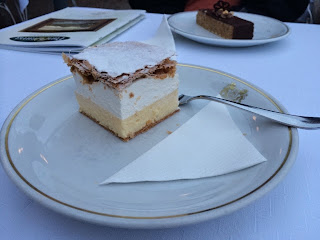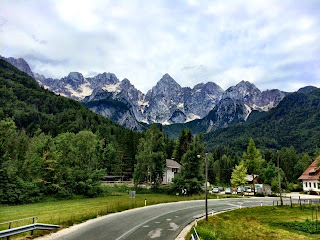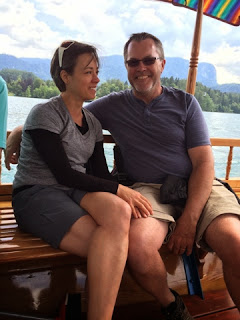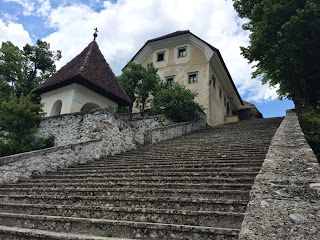We are now in country number three of a total of four on our
itinerary for this trip. We are in Slovenia, a small country that is sandwiched
between Croatia, Italy, Austria, and Hungary at the north end of the Adriatic
Sea. This is my second time in Slovenia, and this second visit has confirmed
for me that this is one of my favorite countries in Europe. Slovenia’s biggest
draw is its varied and spectacular scenery. From its sliver of Adriatic
coastline to its very own section of the mighty Alps, Slovenia packs a lot of
variety and natural beauty into a small package. These last two days in
particular have left me awed at how spectacularly beautiful (and fun) this
little country is.
As you may recall from my last post, our first destination
in Slovenia was Lake Bled, which we reached in the evening after a long day
driving back and forth around northern Croatia on the day before yesterday.
Lake Bled was going to be our home base for exploring the highlights of
northern Slovenia, where we would be spending three nights. On that first
evening we didn’t do much except get ourselves settled, find some dinner at a
great restaurant near our hotel, and take a short walk around the lake. Lake
Bled is a truly beautiful place, a small lake in the foothills of the Alps with
tree-covered hills and snow-capped mountains surrounding it and a cute little
island with a church in the middle. Motorized boats are not allowed on the lake
and the whole area is fairly sleepy anyway, making Lake Bled a tranquil place
to unwind. We had two major activities planned for Lake Bled – a drive through
the Julian Alps, which would take one whole day, and then another day devoted
to the sights and activities in and around Lake Bled itself.
Due to the weather forecast we decided to do the Alps drive
on the first day and the Lake Bled stuff on the second day. The Alps terminate on
their eastern end in Slovenia and Austria (forming the border between those two
countries), and as such Slovenia has some spectacular mountain scenery on its
northern end. We set out from Bled in the morning and drove a loop through the
Alps along a road called the Vršič Pass and then back down from the mountains
through the Soča River Valley. I’m finding myself saying this a lot lately, but
the pictures really speak for themselves. I don’t know that there is anything I
can add to them with my own words. So here they are.
On the second day in Bled we spent the day seeing the sights
around the lake. Lake Bled has been the leading “resort” area in this region,
and really for all of central Europe, for centuries. It is certainly among the
most scenic places I have ever been to in Europe. Everyone there is either a
tourist or someone who makes a living off the tourism industry there, and yet
Bled is the kind of place where that is perfectly alright. It is a great place
to simply enjoy one’s surroundings, and that is exactly what we did. We started
our Lake Bled day by walking the 3.5 mile loop around the lake. It was a great
way to get the lay of the land and see the more remote parts of the lake away
from the main town. There was a film festival (the Bled Film Festival, to be
exact) going on while we were in town and the event had a significant portion
of lakefront real estate cordoned off, although pedestrians were welcome to
walk through. We would occasionally see what I can only assume (or at least I
prefer to believe) were famous Slovenes being interviewed on camera at various
spots around the town, and there was even a red carpet/photo op spot at one end
of the festival. We have since confirmed that one of the people we saw being
interviewed was none other than Armand Assante, of 1997 NBC miniseries “The Odyssey” fame.
After walking around town we took a pletna boat ride to the otok,
the island in the middle of the lake. Pletna
boats are traditional flat-bottomed rowboats that have been used on Lake Bled
for centuries. Our pletna boat pilot
was amazingly deft at maneuvering the boat with just his oars, able to row it
at surprisingly high speed and spin the boat around and back it into its berth
within inches of other boats. I was seriously impressed. It also occurred to me
that I really want his job. By my calculations, given the number of people on
the boat and the price of a round trip to the island and back (which, with a 30
minute stay on the island, took a little more than an hour), the guy brought in
about 180 euros (about 244 U.S. dollars). That’s a lot of scratch for a little
more than an hour of work. Plus his job a) has built in physical activity,
keeping you fit and healthy, and b) would be waaaaaaaaaaaay lower stress than
mine. I wish I could be a pletna boat
pilot back home.
After our trip to the island we had lunch and then drove up
to Bled Castle, on a high cliff overlooking the lake. The castle itself was
mildly interesting, dating from the middle ages when Slovenia was a territory
belonging to the Habsburgs of Austria. What was really fun, however, was the
opportunity I got to operate a replica of the original Gutenberg printing
press. I had found a printing press shop at the castle, where a guy (whose name
I am mad at myself for not remembering) was demonstrating how the press worked
and telling about the history of early printing in Slovenia. They also had
different custom-printed items for sale, and I wanted to have a page printed,
so I explained to the guy what I wanted. He was really accommodating, letting
me put together the design that I wanted, and then he actually let me do the
pressing myself and even stamp the page with a wax seal. It was super cool.






































